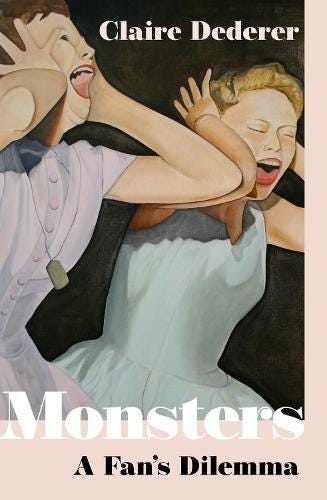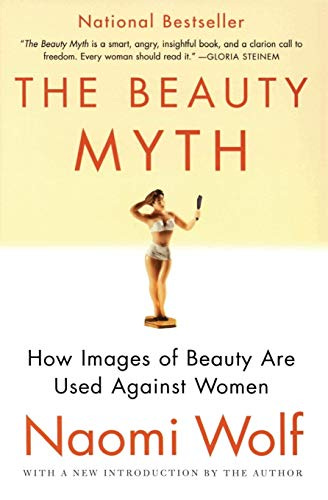Problematic Art
What do we do when the artists we love disappoint us?
Content warning: contains mention of male violence
I was reading an interesting piece in The Guardian last week by author Claire Dederer. A fan of Dederer’s often wincingly frank writing, I first discovered her through her Yoga memoir Poser, in which she discusses both her experience as a new mother as well as reflects on her complicated childhood. It taught me a lot about the effectiveness of the personal essay.
Her later book, Love and Trouble, was similarly part memoir/part comment, this time on ageing, sexuality, and coming-of-age in 20th century Seattle. In the book, she reflects on herself as a teenager and how, in her approaching middle-age, she begins to experience very similar emotions and struggles with her identity.
In Love and Trouble, Dederer also touches on her growing struggles with the art of men whose behaviour and actions have later been - to say the least – questionable, following the fallout of #metoo.
In her new book, Monsters: A Fan’s Dilemma, Dederer goes on to expand on these ideas, working through her own struggles on what it means to love the work whilst struggling with the person behind it.
A victim of predation by men herself, Dederer’s questioning is timely and complex. She references her love of Woody Allen films as an example of this discrepancy, wondering how to reconcile this with his relationship with his former partner’s daughter. She also refers to her disgust at Roman Polanski’s statutory rape of 13-year-old Samantha Gailey, as well as the claims by Lori Mattix, a former 15-year-old groupie who claimed she lost her virginity to David Bowie.
Dederer goes on to ask the question: how do we reconcile our love for the work of such men, whilst recoiling at their later behaviour? She wonders whether or how we can still enjoy watching Louis CK in Parks and Recreation, or dance to a Jackson 5 record on the radio, or our feelings towards Bill Cosby’s role in The Cosby Show, and refers to their various behaviours and biographies as a ‘stain’ on their work.
Not wishing to catalogue the misdemeanors of these so-called ‘art monsters’, she instead wished to reveal how these concerns affected audiences.
“All of this is to say: when I come to this question – the question of what to do with the art of monstrous men – I don’t come as an impartial observer.”
I recently experienced this myself through someone close who had cause to question their long-held love for all things Harry Potter with the now infamous comments of JK Rowling and radical feminism. I find these ideas fascinating, and ultimately complex (as Dederer clearly did to commit them to their own full-length book).
In order to understand this issue better, Dederer began touring college campuses to speak with students.
“These artists did or said something awful, and had made something great. The awful thing disrupts the great work; we can’t watch, or listen to, or read the great work without remembering the awful thing.”
The release of Dederer’s book brings to the forefront the whole idea of cancel culture as well as the question of art consumption. (For an interesting look at the idea of cancel culture and nuance, see Dr Kathleen Waller’s piece on The Matterhorn).
But this idea of fallen heroes doesn’t just rest with these current issues, nor for that matter, solely with male artists.
In my earlier piece on Frida Kahlo and the beauty myth, I touched on Naomi Wolf’s 1990 text of the same name. Within her ground-breaking book, Wolf rails against what she sees as the patriarchal marketing of beauty ideals, forcing women to feel inferior if they did not buy into the beauty standards they had been sold.
But in recent years, Wolf’s reputation itself has taken a somewhat disturbing fall from grace due to her outspoken views. During the Covid pandemic, Wolf faced suspension from social media platform Twitter after she was accused of spreading vaccine misinformation.
Her claims included tweets suggesting that the new vaccines were ‘a software platform that can receive uploads’, as well as advising that the urine and faeces of vaccinated individuals should be separated from the general sewage system until the measure of the impact on non-vaccinated people through drinking water was assessed.
Just as many Twitter users applauded the platform for their suspension, however, there were inevitably others who claimed this as a breach of freedom of speech.
Whilst these claims are clearly in a different class to those of the male artists referred to by Dederer, they can nonetheless cause us to directly question the validity of Dr Wolf’s other ideas, such as in her feminist text.
So what to do with this kind of backlash against someone who, to many women, became a feminist icon through the reading and popularity of The Beauty Myth.
“The Beauty Myth was the kind of book we talked up, borrowed, and never gave back. It made feminists out of many of my contemporaries and helped inspire the feminist Third Wave…” Liza Featherstone, The New Republic.
Yet, as Featherstone points out in her piece for The New Republic, Wolf’s unfortunate tweets were not the first questions raised about the revered feminist writer.
Her book Outrages: Sex, Censorship, and the Criminalization of Love, references (as she sets out to suggest) the relationship between the repression of homosexuality and societal attitudes toward divorce and prostitution. Released in 2019, Featherstone points out that its central argument – that the term ‘death recorded’ meant a convict was executed - was an error, causing the publisher to withdraw the title.
A return to Wolf’s iconic text of the 1990s disappoints Featherstone further. Wolf’s use of data is questionable, to say the least, with one 2004 academic paper strongly disputing her massaging of the numbers to indicate that eating disorders amongst women was akin to a pandemic.
The nuts and bolts of Wolf’s arguments within The Beauty Myth tend toward the action of the individual, as opposed to many of the earlier second wave feminist texts which encouraged societal change. Her third wave feminism appears to stem from an ideal of individualism, which some could argue reflects the political ideas of the 1980s and ‘90s.
“What we decide to see when we look in the mirror…”
Furthermore, in an earlier newsletter, I discussed Rita Mae Brown’s coming-of-age lesbian novel Rubyfruit Jungle. During my research for this piece, I discovered that revered second-wave feminist writer Betty Freidan, author of The Feminine Mystique, openly stated her stance on lesbians within the feminist cause. She saw these women as a distraction from the central issue of women’s politics, naming them the ‘lavender menace’ of the movement.
So where does all this leave us when it comes to considering the art of our former heroes when they are proven to be less than we had hoped?
Dederer says she offers some advice to the students she meets on her campus tours:
“This is what I tell the students: consuming a piece of art is two biographies meeting: the biography of the artist that might disrupt the consuming of the art; the biography of the audience member that might shape the viewing of the art. Your biography, your feelings are important.”
Her inference posits the idea that we bring our own needs and biographies to the art we consume, suggesting that the adolescent who feels like a misfit may find acceptance in Bowie’s lyrics in the same way that Dederer found as a teenager. She goes on to suggest that we can accept the beauty of a piece of art whist abhorring the deed committed by the artist.
“Beauty matters too. We don’t make decisions about beauty. Like the stain, beauty happens to us.”
It’s a complex matter; both the idea of consuming the work of otherwise unsavoury individuals, and that of the proliferation of cancel culture, and I admit to not having an answer. My response to my loved one’s angst over JK Rowling’s ideas and their childhood love for her work is similar to Dederer’s: to accept the work for what it is and for what it meant to them when they encountered it; and for the comfort they continue to receive from it.
Once an author or artists’ work has been released into the world, it becomes the property of the reader or viewer; it is up to us to interpret the meaning it holds for us at any given moment.
But if the thoughts and ideas of its creator begin to impinge on our enjoyment of the art, we also have the choice to look away.




Thank you for this, I found it really helpful. I don't like feeling that I'm being bullied into disliking something that has been an important part of my life. I am never not going to love Annie Hall!
A friend of mine raved about this book and you’ve now added to my need to read it. Thank you for an excellent newsletter. It really sounds like she’s approached the subject with the nuance it needs and deserves. I definitely feel this resistance to let go of favourite works from creators who now feel problematic to my principles. The honest reality is it’s often not an on/off switch decision. Here’s to more conversations in the grey areas.